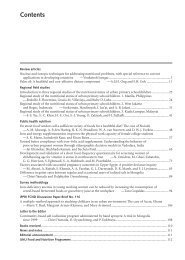The epidemiology of good nutritional status among children - BVSDE
The epidemiology of good nutritional status among children - BVSDE
The epidemiology of good nutritional status among children - BVSDE
Create successful ePaper yourself
Turn your PDF publications into a flip-book with our unique Google optimized e-Paper software.
312<br />
<strong>The</strong> number <strong>of</strong> slum settlements has grown rapidly in<br />
recent years and the urban poor are now estimated at<br />
around 11 million, or 37% <strong>of</strong> the urban population 16 .<br />
Fourteen per cent <strong>of</strong> the urban population lives below the<br />
poverty line and the largest gap between the rich and the<br />
poor is in the urban areas 15 . However, 50% <strong>of</strong> the slum<br />
population lives below the poverty line 17 .<br />
<strong>The</strong> Urban Livelihoods Study is based in the slum<br />
settlements <strong>of</strong> Mohammadpur subdistrict <strong>of</strong> Dhaka City.<br />
Agargoan includes the biggest slum in Mohammadpur.<br />
<strong>The</strong> land is owned by the government but has been<br />
occupied informally by squatters for over 20 years. Central<br />
Mohammadpur includes slums in Rayer Bazaar, Jafrabad,<br />
Pisciculture, Adabar and Pulpar Bottola areas. Most <strong>of</strong> the<br />
slums in this area consist <strong>of</strong> poor housing within middle<br />
and lower-middle class residential housing settlements.<br />
Private landlords own most, though some are on disputed<br />
land. Finally, Beri Badh is the peripheral area <strong>of</strong><br />
Mohammadpur. <strong>The</strong> settlements have been developed<br />
along the embankment <strong>of</strong> the Dhaka City Flood<br />
Protection, alongside the Buri Ganga River. <strong>The</strong> embankment<br />
is government-owned land, with slums adjacent to<br />
the embankment situated on privately owned land.<br />
Study design<br />
Data collection is based on two sets <strong>of</strong> interrelated<br />
activities: quantitative data collection on a panel <strong>of</strong> around<br />
850 households – termed the quantitative panel survey –<br />
and qualitative studies which explore the same study<br />
objectives within selected slum settlements in the study<br />
area. Panel households were selected through a random<br />
cluster sample <strong>of</strong> all slum areas in Mohammadpur, with<br />
stratification for geographical area. Twenty-five clusters <strong>of</strong><br />
households were sampled across Mohammadpur<br />
subdistrict.<br />
Sample size was calculated using standard statistical<br />
formulae at the outset <strong>of</strong> the study, on the basis <strong>of</strong> being<br />
able to detect differences in adults and <strong>children</strong> between<br />
socio-economic groups <strong>of</strong> the population. <strong>The</strong> sample size<br />
was inflated to allow for the fact that cluster sampling was<br />
employed. <strong>The</strong> process suggested that the sample should<br />
be at least 700 households.<br />
Households were followed up on a monthly basis. <strong>The</strong><br />
monthly questionnaire was administered to the head <strong>of</strong><br />
household and spouse, and enquiries were made into<br />
work participation, sources <strong>of</strong> income, changes in<br />
financial <strong>status</strong>, shocks, stresses, coping strategies and<br />
food expenditure. Acute and work-disabling morbidity<br />
was recorded for a 2-week recall period and anthropometry<br />
was carried out on the household head, spouse<br />
and <strong>children</strong> below 5 years <strong>of</strong> age.<br />
Every third month a more extensive data collection<br />
interview took place, this time involving the head <strong>of</strong><br />
household, spouse and all resident family members. At this<br />
interview detailed additional information was collected on<br />
debts and savings, income from employment and other<br />
sources, asset ownership, sale and purchase, food supply<br />
and food stocks, food expenditure, total expenditure,<br />
child feeding practices, common property resource use,<br />
social relations (trades union/committee/non-governmental<br />
organisation membership and activities), use <strong>of</strong><br />
amenities and environmental situation. Changes in<br />
financial <strong>status</strong>, self-reported morbidity and anthropometry<br />
were documented for all household members.<br />
Quality assurance was a high priority. Every week,<br />
supervised interviews, re-interviews and spot checks were<br />
conducted and supervisors checked that questionnaires<br />
were completed properly. Age <strong>of</strong> the mother was assessed<br />
using a marriage questionnaire, in which she was asked<br />
her age when she started to live with her partner, age<br />
when she got married and age at each birth, and finally her<br />
current age. <strong>The</strong>re was <strong>good</strong> agreement (within 6 months)<br />
between the calculated age from the marital questionnaire<br />
and declared current age. Consumption units were<br />
calculated using a standard method based upon energy<br />
requirements <strong>of</strong> men and women <strong>of</strong> different ages (see<br />
Appendix). Double entry <strong>of</strong> the data was done to minimise<br />
errors in data entry.<br />
Statistical analysis<br />
<strong>The</strong> analysis draws on data collected from the quantitative<br />
panel survey conducted during September–November<br />
1996. Complete data were collected on one occasion<br />
during the 3-month period (the ‘3-monthly round’).<br />
Individual child-specific <strong>nutritional</strong> <strong>status</strong> was based on<br />
height-for-age Z-score (HAZ), with <strong>children</strong> having HAZ<br />
.22 (better <strong>nutritional</strong> <strong>status</strong>) being compared with the<br />
remainder (HAZ ,22, worse <strong>nutritional</strong> <strong>status</strong>). <strong>The</strong><br />
independent variables were organised into groups<br />
approximating quartiles, to allow for the identification <strong>of</strong><br />
non-linear relationships in a statistically powerful way.<br />
Chi-square and t-tests were carried out to test for<br />
differences between <strong>children</strong> with better and worse<br />
<strong>nutritional</strong> <strong>status</strong>. We then used logistic regression with<br />
adjustment for clustering, the SVYLOGIT command in<br />
Stata, to identify independent predictors (Stata Corp.,<br />
College Station, TX, USA, 2002). <strong>The</strong> risk factors that<br />
showed statistically significant or close to significant<br />
associations were entered into the logistic regression. <strong>The</strong><br />
logistic regression model incorporated child’s age in<br />
months, income, savings per consumption unit, mother’s<br />
height, parity, gender <strong>of</strong> household head, area <strong>of</strong><br />
residence, room height, type <strong>of</strong> child’s latrine, electricity<br />
in the home, floor area, father’s working days <strong>of</strong>f due to<br />
illness, mother’s home days <strong>of</strong>f due to illness and dry<br />
season’s cooking location as independent variables, with<br />
HAZ .22 as the dependent outcome.<br />
Results<br />
JA Pryer et al.<br />
Table 1 shows economic variables for better and worse<br />
<strong>nutritional</strong> <strong>status</strong>. Income and loans were higher for
















